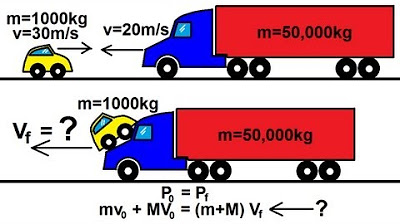Introductory Elastic Collision Problem Demonstration
Summary
TLDRIn this engaging and educational video, the hosts tackle an elastic collision problem involving two carts with different masses. Through a combination of humor, step-by-step explanations, and a bit of banter, the group demonstrates how momentum and kinetic energy are conserved (or nearly conserved) in the collision. They walk through the necessary calculations, including the use of relative error and significant figures, to determine the final velocities of both carts. The discussion also touches on the importance of measurement units, and the lesson concludes with a light-hearted exchange about using the correct units for energy calculations.
Takeaways
- 😀 It's hat, wig, vest, and sword day, a fun tradition to avoid a boring hat day.
- 😀 The problem involves two carts with different masses, one moving and one at rest, undergoing an elastic collision.
- 😀 Momentum is conserved during the collision, and the equation for momentum conservation is used to find the final velocity of cart 2.
- 😀 The formula for momentum conservation: mass1 * velocity1_initial + mass2 * velocity2_initial = mass1 * velocity1_final + mass2 * velocity2_final.
- 😀 The final velocity of cart 2 is calculated to be 55.0 cm/s using momentum conservation.
- 😀 The significant digits rule is discussed, emphasizing treating the mass ratio (2) as an exact number to maintain precision.
- 😀 A graph is used to determine the observed velocity of cart 2 after the collision, which is 52.8 cm/s.
- 😀 The relative error formula is applied, yielding a 4.00% negative error between the observed and accepted velocity of cart 2.
- 😀 The concept of kinetic energy conservation is introduced, and the class discusses the conservation of energy during the collision.
- 😀 Although kinetic energy is not fully conserved (94.1% retained), the class acknowledges the need for more trials to confirm this.
- 😀 There is a discussion about using centimeters per second for calculating energy and the importance of unit consistency, with a humorous exchange about ergs.
Q & A
What is the significance of 'hat, wig, vest, and sword day' in the video?
-The phrase 'hat, wig, vest, and sword day' is used as a playful reference to a tradition where students or participants wear various accessories instead of just hats. It contrasts with 'hat day' from the previous year, where everyone wore simple baseball caps.
What is the main concept being demonstrated in the video?
-The video demonstrates an elastic collision problem, focusing on the conservation of momentum and kinetic energy during the collision of two carts with different masses.
Why does Bo say mass 1 equals '2m' and mass 2 equals 'm'?
-Bo is explaining the masses of the two carts: Cart 1 has twice the mass of Cart 2, so Cart 1's mass is represented as '2m' and Cart 2's mass as 'm'.
How does the conservation of momentum apply in this problem?
-Momentum is conserved during the collision, meaning the total momentum before the collision equals the total momentum after the collision. This is expressed with the equation: mass 1 * velocity 1 initial + mass 2 * velocity 2 initial = mass 1 * velocity 1 final + mass 2 * velocity 2 final.
How is the final velocity of Cart 2 determined in this scenario?
-The final velocity of Cart 2 is calculated by using the conservation of momentum equation and solving for the unknown final velocity of Cart 2, which comes out to 55 cm/s.
What is the reasoning behind using three significant figures for the final velocity of Cart 2?
-Since the mass ratio (2m) is treated as an exact number, it does not affect the significant figures in the final answer. Therefore, the final velocity of Cart 2 is reported with three significant figures, 55.0 cm/s.
Why does the observed velocity of Cart 2 after the collision differ from the calculated value?
-The observed velocity of Cart 2 after the collision is 52.8 cm/s, which is lower than the calculated value of 55.0 cm/s. This discrepancy is due to experimental errors, which are quantified as a relative error of -4.00%.
What does relative error indicate in this context?
-Relative error in this context indicates the difference between the observed value (52.8 cm/s) and the accepted value (55.0 cm/s) as a percentage, reflecting the accuracy of the measured velocity.
Why does the instructor suggest that kinetic energy is not perfectly conserved in the collision?
-The instructor shows that the ratio of final to initial kinetic energy is 94.1%, which means that a small amount of kinetic energy was lost during the collision, suggesting that kinetic energy is not perfectly conserved in this particular scenario.
What is the argument made by Mr. Becke regarding the use of centimeters when calculating kinetic energy?
-Mr. Becke argues that using centimeters when calculating kinetic energy is not ideal because energy is typically measured in joules, and the correct units involve meters, not centimeters. He suggests that it is better to use SI units, like meters per second, for calculating energy.
Outlines

This section is available to paid users only. Please upgrade to access this part.
Upgrade NowMindmap

This section is available to paid users only. Please upgrade to access this part.
Upgrade NowKeywords

This section is available to paid users only. Please upgrade to access this part.
Upgrade NowHighlights

This section is available to paid users only. Please upgrade to access this part.
Upgrade NowTranscripts

This section is available to paid users only. Please upgrade to access this part.
Upgrade NowBrowse More Related Video

Collisions Demo: Two Carts

Conservation of Momentum | Elastic and Inelastic Collision | Grade 9 Science Quarter 4 Week 4

Introductory Perfectly Inelastic Collision Problem Demonstration

Elastic and Inelastic Collisions

Physics 10 Momentum and Impulse (5 of 30) Why you Don't Want to Collide with a Semi Truck

Tumbukan 1 Dimensi
5.0 / 5 (0 votes)